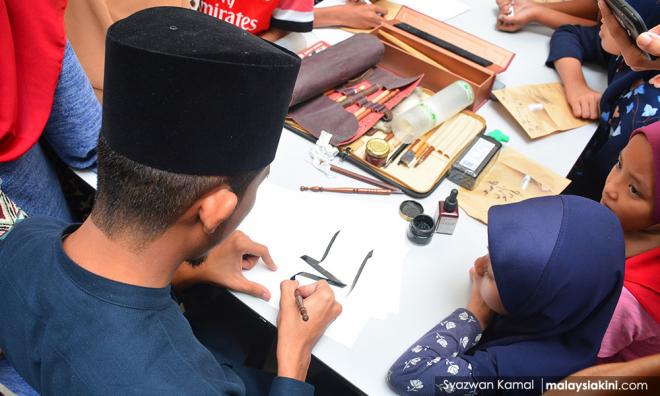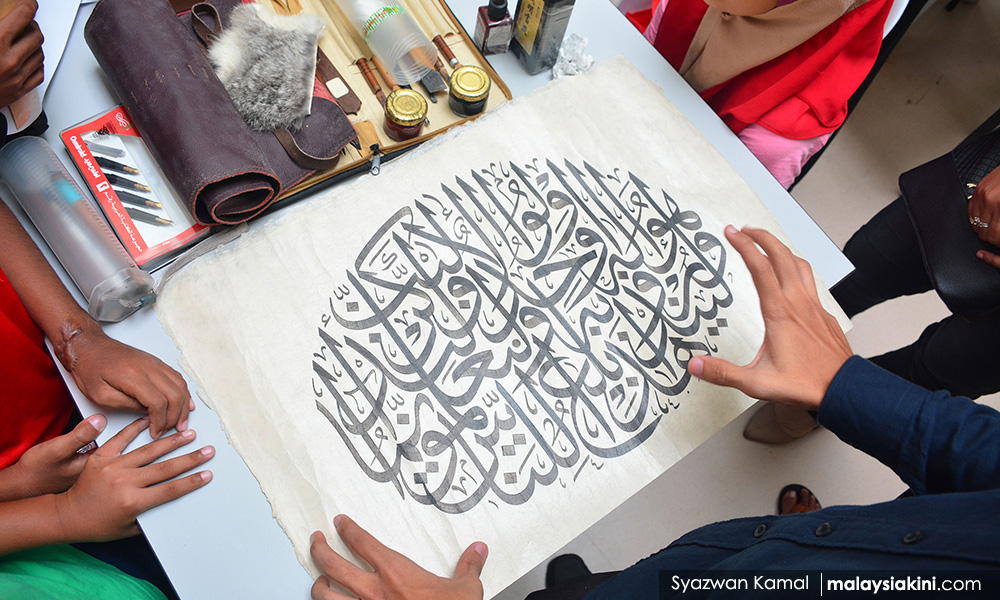
Even as an international award-winning calligrapher, 25-year-old Ahmad Abdul Hadi said his skills still pale in comparison to true masters of the art.
Even so, for over an hour this morning, Ahmad guided a group of participants who attended a khat writing workshop and competition hosted by Lembah Pantai MP Fahmi Fadzil at the local community library in Bukit Kerinchi, Kuala Lumpur.
The children from as young as six-years-old looked on curiously as Ahmad displayed his arsenal of writing tools - from pens made of wood, metal and ivory, a special ink with silk threads to control its flow and a square of rabbit skin used as a wrist pad.
Their parents, meanwhile, quizzed Ahmad on the historical origins of khat and its various techniques.

While participants today learnt the basics of khat writing on plain white paper, Ahmad said many of his designs were produced on special papers imported from Turkey - coated with egg white to prevent the ink from spreading, along with an additive that neutralises the smell of eggs.
As a result, Ahmad said the final designs could be preserved for hundreds of years and there are many such examples dating from the time of the Ottoman Empire.
He said there are hundreds of writing styles developed since the time of Prophet Muhammad SAW through his companions who took down revelations from Allah SWT, but seven are formally recognised and used in Malaysia.
"The most recognisable style is Khat Nasakh, used here in our Al-Quran, school books and newspapers.
"A larger script used for example in mosque designs is known as Khat Thuluth," explained Ahmad, whose personal experience includes spending nine months writing two Al-Quran chapters for a local publisher specialising in a handwritten form of the text.
"It took me two months just to master the skill of making 'square dots' used as a size and scale guide for each character," he recalled, adding that the end goal for any khat-based design is to achieve a "golden ratio" between all elements.

When met later, Ahmad told Malaysiakini he believes that social media is an important platform to encourage wider participation in programmes such as the session hosted today.
"The public should promote these types of programmes so that people realise that khat writing is not an attempt at Islamisation.
"Everyone can learn it. It is not only used to write Quranic verses like we have the Jawi script, and khat is used to write Jawi in a beautiful style," he said.
Ahmad said the National Khat Association, which he is a member of, also remains open to engagements with the education ministry in efforts to promote the calligraphy as a Malay heritage and national identity.

When contacted later, Fahmi said the programme's evening session saw participation from a multi-racial group including the Malaysian Chinese Muslim Association (Macma) and other residents in the area.
"We wanted to demystify the idea that Jawi is synonymous with a particular ethnic group," said Fahmi who presented prizes to winners of various Jawi related competitions held today.
Critics of the government's move to introduce Jawi writing lessons in vernacular schools had previously suggested for it to be taught as part of art lessons rather than Malay language studies.
Most recently, the NGO Seni Khat Action Team (Sekat) adopted seven resolutions which included a call for Jawi to be made an elective subject, rather than incorporated into the Year 4 Bahasa Malaysia syllabus for vernacular schools this year. - Mkini



No comments:
Post a Comment
Note: Only a member of this blog may post a comment.